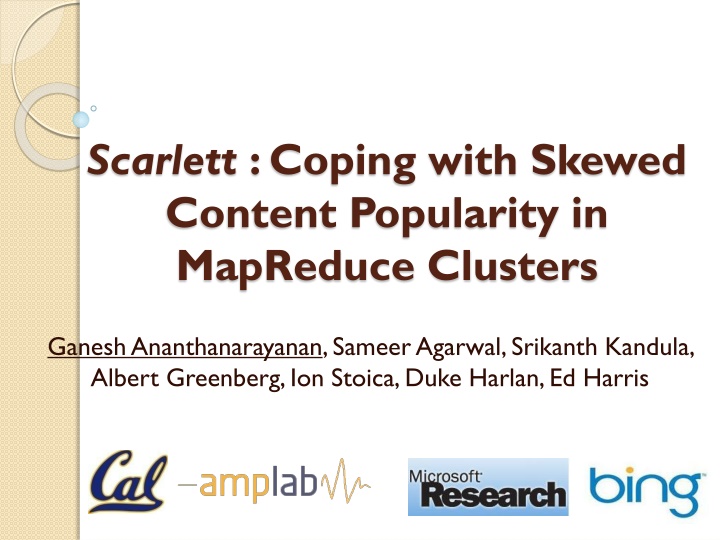
Coping with Skewed Content Popularity in MapReduce Clusters
Explore challenges and solutions for managing skewed content popularity in MapReduce clusters, addressing issues like slot contention, replication strategies, storage space optimization, and task queue contention. Learn from real-world production logs and discover effective ways to handle popularity skew and mitigate contention in distributed computing environments.
Download Presentation

Please find below an Image/Link to download the presentation.
The content on the website is provided AS IS for your information and personal use only. It may not be sold, licensed, or shared on other websites without obtaining consent from the author. If you encounter any issues during the download, it is possible that the publisher has removed the file from their server.
You are allowed to download the files provided on this website for personal or commercial use, subject to the condition that they are used lawfully. All files are the property of their respective owners.
The content on the website is provided AS IS for your information and personal use only. It may not be sold, licensed, or shared on other websites without obtaining consent from the author.
E N D
Presentation Transcript
Scarlett : Coping with Skewed Content Popularity in MapReduce Clusters Ganesh Ananthanarayanan, Sameer Agarwal, Srikanth Kandula, Albert Greenberg, Ion Stoica, Duke Harlan, Ed Harris
Data Locality Frameworks: MapReduce, Hadoop, Dryad Job {Phase} {Task} Map phases constitute 59% of lifetime, 68% of resources [Microsoft Bing] Co-locate map task with its input Network capacity is limited Data blocks are replicated three times
Problem: Slot Contention Task Queue Contention Resolution Run remotely Evict and run Dryad Slow Read Wasted Work
Slot contention is a big deal In Dryad [Microsoft Bing]: 21% of tasks get evicted and re-run One-fifth of the cluster practically wasted! Valuable resource for outlier speculation etc. In Hadoop [Facebook]: Node-locality for only 57% of map tasks; small jobs achieve only 5% node-locality Increases load on (already) under-provisioned network
Replication is a natural solution Task Queue Contention Avoidance Contention Resolution
Storage space is a crunch Storage is more than 50% total cost Non-linear increase for new datacenter Facebook and Microsoft datacenters MS: 3 replicas to 2 FB: 3 replicas (1 replica + reed-solomon code) How do we replicate data while not wasting scarce storage space?
Production Logs Logs from Bing cluster with thousands of machines, sampled over six months 200K jobs, 400K phases, 300PB of data, 10PB network transfers Task-level details Production and experimental jobs
Popularity Skew Concurrent Accesses: #Simultaneous Jobs accessing a file Total Accesses: #Jobs accessing a file Top 12% is 10x more popular than bottom third 18% data is accessed three times concurrently
Skew Contentions Top 1% of contention-causing files account for 60% of contentions have 9x more total accesses have 2.5x more concurrent accesses Access counts correlates with contention Gain by replicating popular files
Scarlett replicates data to predicted popularity, using budgeted storage
Design Choices file Replication granularity: file vs. block All or none of a file is accessed outliers Simple to implement Proactive Proactive vs. Reactive Ability to deal with evictions
Scarlett: System Design Increase replication for files Avoid hotspots of popularity Efficient Replica Creation
Calculate replication factor Calculate every rearrangement window TR Use learning window of TL f1 f2 Concurrent Access in TL (Ja, f1) (Jb, f1) TR (Jd, f2) (Je, f2) 2TR (Jc, f2) time TL
Overlap in data access Data accessed on day n+1 Data accessed on day n Predictabilityn = Predictability (%)
Replication Budget Storage budget limits overhead How to distribute the budget? Priority Round-robin (Total Access x Size) (3) File A File B (3) File C (2) File D (2) Budget Budget
Scarlett: System Design Increase replication for popular files Avoid hotspots of popularity Efficient Replica Creation
Hotspots 50% of the contentions happen in 16% of the cluster
Smooth placement of replicas One replica per rack Rack-local bandwidth ~ Disk bandwidth Load-factor of machine/rack is ratio of desired to achieved replication factors Balance load on machines and racks Files in desc. order of (Total Access x Size) Place new block in least loaded rack/machine
Scarlett: System Design Increase replication for popular files Avoid hotspots of popularity Efficient Replica Creation
Spread Replication Traffic Each old replica is a source for (rnew rold)/ rold new replicas Replicas increase, at most, in steps of 2 Data flowing per link remains constant rold = 1 rnew = 4 Rack Data 1 2 4
Compress Replication Traffic Cross-rack bandwidth is over-subscribed Lenient latency constraints to finish replica creation Text data yields high compression ratios Spare cores available for compression
Evaluation 1. Does Scarlett s replication increase locality and reduce evictions? 2. How much extra resources does Scarlett s replication consume?
Setup Hadoop deployment 100-node cluster 10 hour workload, 502 jobs Dryad simulator Detailed replay of the entire trace Jobs and cluster characteristics
Does locality improve in Hadoop? Baseline is vanilla HDFS, 3 replicas per block TR = 5 hours, Budget = 10%, Priority distribution Locality 57 92% Job Speed-up (Median) Job Speed-up (75th percentile) 20.2% 44.6%
What if one replica per block? Locality with (1 replica per block +13% budget) is equivalent to 3 replicas per block (Base Replication: 3) Scarlett helps future datacenters deal with storage crunch 25
Are evictions avoided in Dryad? Evictions down by 83% For top 100 popular files, by 93% Scarlett is within 16% of an ideal scheme that has perfect knowledge of #replicas
Replication Overhead Budget: Using 10% extra storage achieves near-optimality Priority is 52% better than round-robin Sufficient to rearrange once in TR=12 hours Less than 1% increase in network traffic
Summary Data popularity skew contention for slots Scarlett: Contention-Avoidance system Popularity-based proactive replication of files Limited storage and network overhead Near-ideal elimination of contentions using under 10% extra storage Increased value under storage crunch (1 replica + 13% budget 3 replicas)




